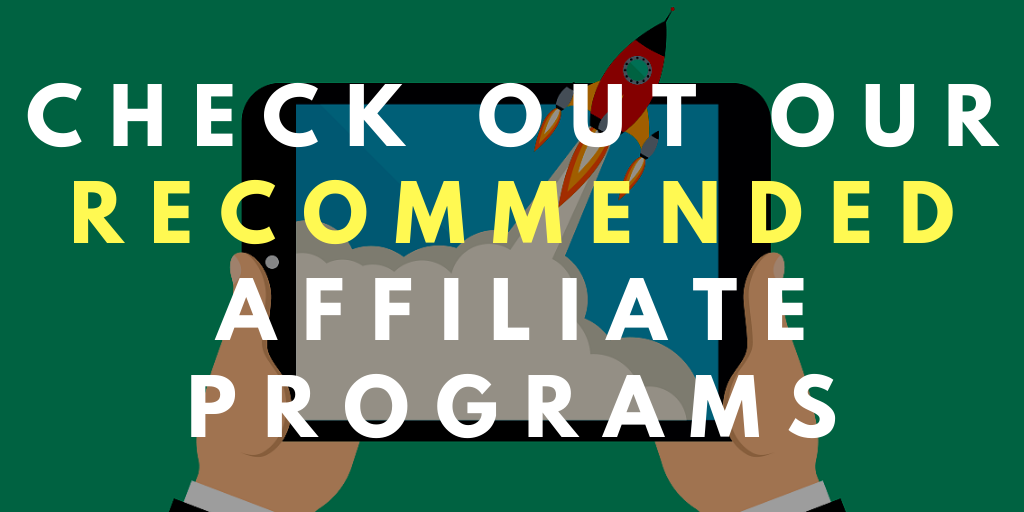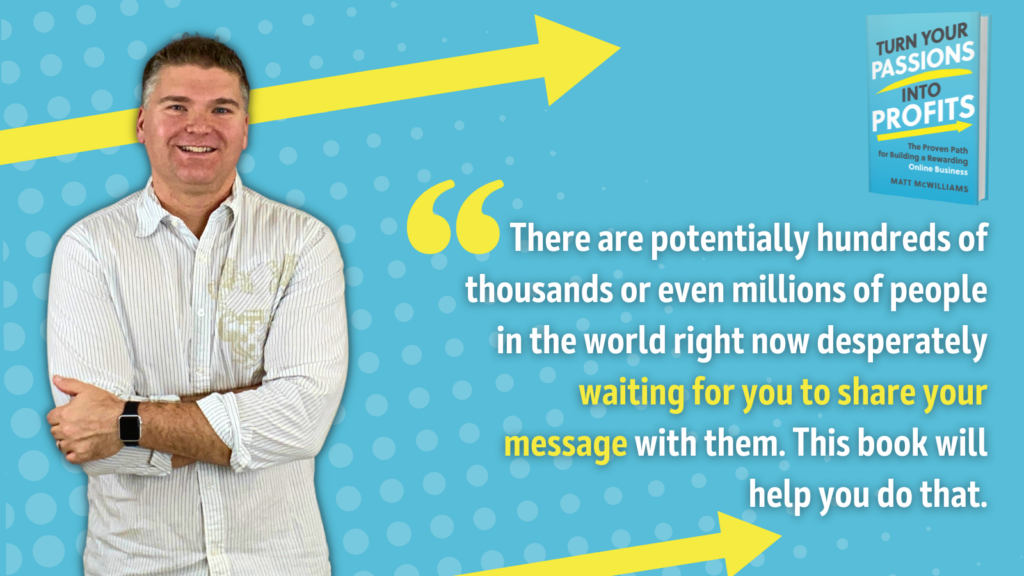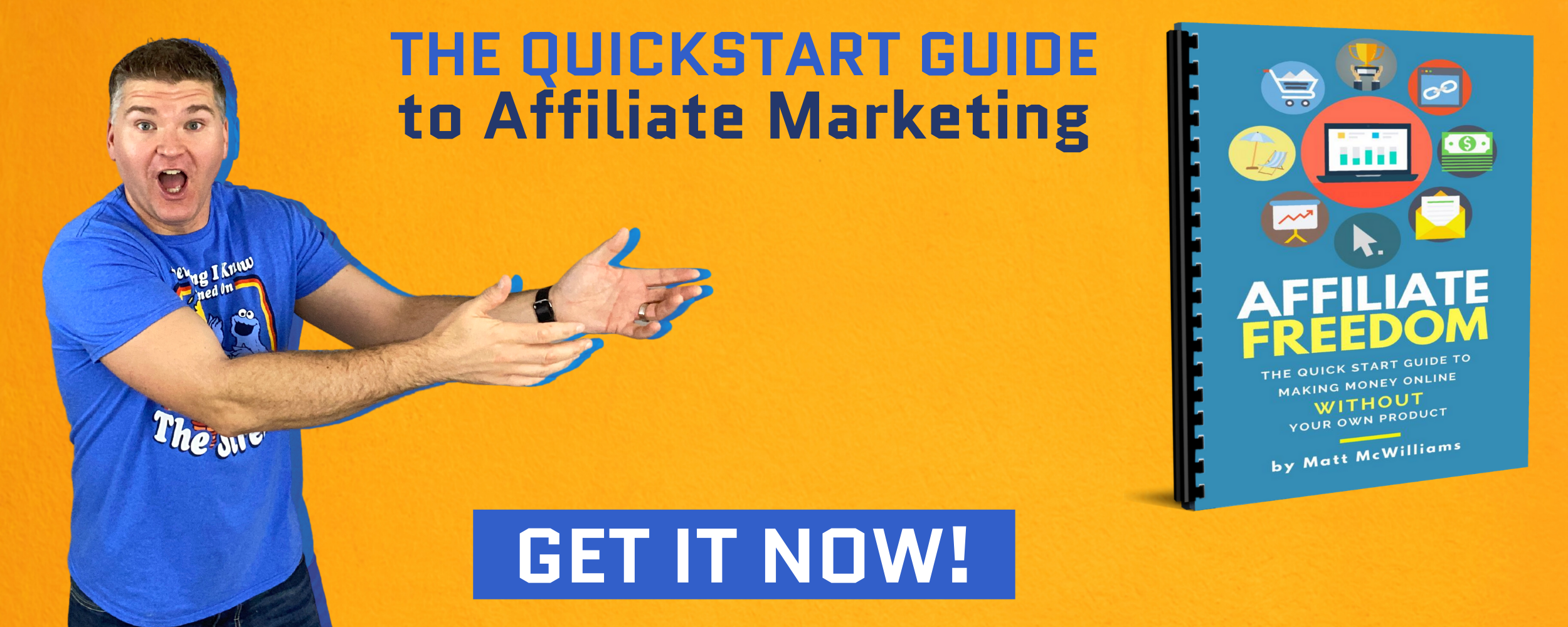One of the hardest parts about an affiliate promotion is shifting from promoting the free content (workshops, pdfs, reports, webinars, etc.) to promoting the paid content. It’s a challenge to go from “here’s a free thing you might like” to “now you have to pay money for this.” I’m seeing a lot of affiliates really struggling with this so I want to share my best tips with my favorite people (my podcast listeners) on how to do this effectively. Listen up and I’ll share exactly how to transition from promoting free content to paid products.
Click Here for The Written Transcript of This Episode
Tired of having a small (or no) email list? It’s time to start growing your fast and easy! Grab my new book Turn Your Passions Into Profits now and watch our subscribe count soar!
Links Mentioned in this Episode
Turn Your Passions into Profits Book & Exclusive Bonuses
Our Recommended Affiliate Programs
How to Put Together an Affiliate Bonus Package
Text me at 260-217-4619
Don’t Miss An Episode – Subscribe Below
Previous Episodes of The Affiliate Guy
Book Launch Party: An Interview with Matt About Turn Your Passions Into Profits
Special Episode: Highlights from My Whirlwind Book Tour
The Untold Stories from Turn Your Passions Into Profits (Behind The Scenes Peek at My Book)
Ten Resolutions for Affiliate Marketers and Affiliate Managers
2023 Affiliate Marketing Predictions
Creating Your Ideal Customer Avatar: How to Get Crystal Clear on Your Audience Part 2
How to Get Crystal Clear on Your Audience Part One
Affiliate Marketing Lesson: Shifting From Promoting Free Content To A Paid Product
One of the hardest parts about an affiliate promotion is shifting from promoting free content like workshops, the free reports, the webinars, to promoting the paid content.
It’s a challenge to go from here’s a free thing you might like to now you have to pay money for this, and I’ve seen a lot of affiliates really struggling with this.
So I want to share my best tips with my favorite people. That’s my podcast listeners on how to do this effectively to listen up, and I’ll share exactly how to transition from promoting free content to paid products.
So welcome back to our regularly scheduled programming. Now that we’re post book launch here and we’ve had a successful book launch, I don’t know what the numbers are.
I’d love to be able to tell you what we did, but I don’t know yet because I’m prerecording this, of course and I do know that we’ve been number one on Amazon in multiple categories.
I know that we’ve been top five business book on Barnes and Noble. We even beat Amy Porterfield, Lewis Howes, even Bernie Sanders, which is kind of cool.
How he got in the business category, I’ll never know, but whatever, we beat him. So, again, number one, multiple categories on Amazon. Just unbelievable time.
So we’ll see if the hard work paid off. If we hit the other big lists, we’ll see. But we’ve accomplished almost everything we set out to accomplish with the book launch.
So for all of those who have purchased the book, thank you so much. Means the world to me. So many people. I got probably 50 texts yesterday, about 100 Facebook messages, and just people holding the book saying, got it.
Look what came today and I was like, that’s so cool. So if you haven’t yet, you can go to passionsintoprofitsbook.com we’ll put the link in the show notes.
There’s still an opportunity there to get a ton of exclusive bonuses. They’re not as good as the pre order bonuses, but you don’t want to miss out on those bonuses. So go grab a copy if you haven’t yet.
Well, today is one of my favorite things to teach because I see so many people struggling with this. You think of promoting a launch or other affiliate promotion, like a mountain, right? We got to go up the mountain.
That’s the warm up, the getting opt ins, getting registrations for free workshops, downloading PDFs, registering for the webinar.
And then what we typically see is affiliates who do a great job getting their audience up the mountain, and then they get them almost to the peak, which is where the sale happens.
They come so close to making the sale. They come so close before they fall. They’re just tired. The launch is dragging on, the promotions dragging on and if all they did was just keep going just a little bit, they’d finish strong.
And part of that is shifting from the free content to the paid content. Now, this could mean a couple of different things. This could mean that you’re warming your people up for a promo with blog posts and videos and all that, right?
We’re warming them up. We’ve talked about warming up. If you just go to Matt Mcgwains.com and type in warm up, you’ll see, I’ve done a few podcast episodes and blog posts about how to warm up your audience in advance of a promotion.
So you might just be going straight into sales, though. You’re going to warm them up and then sell, or you’ve warmed them up and now you’re into the pre launch content.
So you’ve got the workshop, you’ve got the webinars, the challenge, videos, things like that, right? and then you go into selling.
So right now you’re at the end of just promoting the free stuff. Maybe you promoted the workshop or the webinar you’ve been focused on for a week or so, promoting free entry points.
Either way, at some point you need to shift from the free content to a paid offer and it goes from being really easy with the free stuff to suddenly it’s a challenge.
Suddenly it is difficult. So what happens is that a lot of affiliates decide they’re just going to promote the free content. They think they can just promote the video series, the workshop, the ebook, the free report, and they’re not going to sell.
They’re not going to do any sales of their own and then they make no sales. Like, I’m not going to sell and then you make no sales and you’re like, well, wow, that’s a surprise, right?
If you’re going to make more than just a few sales, or any sales, if you have a smaller list, if you’ve only got a few hundred people and you get 30 opt in, you might make no sales if you don’t actually sell.
If you’re going to make a bunch of sales, even if you have a bigger list, you got to do some selling. You’ve got to be the one doing a little bit of selling.
So one of the things you have to remember, somebody opts in through your affiliate link to my Workshop, for example.
They opt in to my webinar. They’ve known me for a week and now I’m asking them to purchase something.
The reality is that most of the people don’t trust me yet. They need time, but they still trust you. You’re the person.
They’ve been on your list for six months, a year, two years, so they trust you. So when you say Matt’s product is amazing, they buy it. That’s how that works.
And by the way, if you want to be an affiliate for us, we’d love to have you. If you just go to MattMcWilliams.Com/whatsup, we’ll put that link in the show notes.
We’ve got tons of recommended affiliate programs on there. Our clients and some people that I trust in the industry and some of the programs on there are affiliate programs.
So just as a side note, if you’re looking for something great to promote, go to Mattmcwilliams.com/WhatsApp got tons of great stuff there.
So the thing is, you’re the person they trust. So you’ve got to do a little bit of selling and today I want to share how to do that.
So how do we shift from just promoting the free content to promoting a paid product?
The first thing you’ve got to do is you got to master the basics of selling. All right?
The basics of selling, basic number one is you got to have fun.
You got to have fun.
Part of this is psychological. When we’re having fun, you’re just going to be better at something when you go into it than when you go into it with a sense of dread.
You are going to be better when you’re having fun than when you’re not having fun. Things that you dread aren’t fun, and you have a different cadence, you have a different personality.
That’s what I experience. When there’s things that I dread, I just don’t give them 100% and I want you to let your personality shine through.
So what is your personality with your audience? If you’re just a fun person, you’re kind of goofy. Then be goofy in your sales messages.
Don’t suddenly start getting serious. Don’t be more proper, more professional, more like a college professor.
If you’re more like the college professor than be like the college professor in the selling. Don’t try to be a goofball fun guy when you’re selling, if you’re normally the dry college professor guy.
Secondly, don’t use the sales voice.
The sales voice, it goes back to what I just said, right? The sales voice is the voice you think you’re supposed to use to sell something.
I’ve done entire episodes on this. It applies not only in speaking, but in print. It reads differently than your regular voice to the listener.
To the reader, it’s alarming. It’s obvious that something is different and when I use my sales voice verbally, I sound different.
Like monster truck commercial guy. Monday, Monday, Monday Like Cheesy used car salesman guy. That’s how I sound. When I use a sales voice, even my writing takes on a different tone.
I stop using humor as much. I write in a different format than normally. I use words I think I’m supposed to use to sell and as a result, I’m no longer myself.
Looking for some good affiliate programs to promote? Check out our recommended affiliate programs here!
It always backfires when you do this. When I do it, it always backfires. Not only do I not make the sale, but I lose trust, I lose likability, I get off brand.
These are business killers long term and I see people make this mistake so often they start using this sales voice.
So I shared it in previous episodes. But I’ll just give you kind of a quick recap here.
Why do you use a sales voice and how do you fix it?
The first reason is you try too hard, so you’re trying too hard and again, I’ve talked about it in past episodes, so I won’t go into all the detail here.
But when you try too hard, you use your regular voice. You sound desperate. Desperation is a major sales killer and as easy as it sounds, simple as it sounds, the solution is to try less. Ask for the sale, but don’t sound desperate or needy.
Second thing is you try to be someone else.
You think that you have to be someone else in order to sell. Don’t try to be someone else when you’re selling. Be yourself.
You can observe others, you can learn from others. You can have a Swipe file, but pick and choose what you copy from.
The third thing is you haven’t clearly defined your brand.
I talk about this in the book and I shared it a few episodes ago where I shared some of the excerpts from it. You need to have a clear archetype. The seven archetypes, right?
The master maestro, the venerable visionary, the jolly journey, and the hesitant hero, and so on and so forth. You have to define your brand and your voice.
Write out your brand statement, write out your unique personality or style, and it’s important to be crystal clear on that and stick to it.
You can’t be the cordial caregiver like Mary Poppins, and then in your regular content and be all loving on your audience.
And then be the revolutionary rebel where you’re just mad as h*** and you’re not going to take it anymore.
You can’t be Indiana Jones or Ferris Bueller in your sales messages. So clearly define your brand.
The fourth reason is you learn too much.
Now, I’m a big fan of learning. You should listen to all my podcast episodes. You need to do that, right?
But you can read so much and learn so much about sales and all the latest techniques and chat GPT, and then there’s this other stuff, and then there’s Facebook, and then there’s Instagram and all these things.
It’s not that complicated. Affiliate marketing is very simple.
Number one, you get people to know, like and trust you.
Number two, you make recommendations about products that you like and that will benefit them. That is the formula. So stick to the basics. Stop trying so many new things in such a short period of time.
Then the last reason you end up using sales voice is that you copy the Swipe. Copy exactly as it is. Don’t do this, don’t do it. You cannot copy the swipe. Copy exactly as it is. Alright?
So those are some of the reasons why we use sales voice and you have to stop using the sales voice, right? So that’s a couple reasons there.
Number one, in terms of how do you get the basics of selling.
Number one, have fun.
Number two, don’t use the sales voice.
The third thing is you gotta use repetition.
You gotta use repetition, all right?
So you got to be like nickelback. You got to be like nickelback. Like every song they have is exactly the same. If you’ve heard one song, you’ve heard them all.
That’s exactly why they’re one of the bestselling bands of all time. I can’t stand nickelback, but they are everywhere and for good reason.
Repetition predictability, if you think about it, if you look up, go look up a mashup of their songs, there are mashups of their songs. The songs are virtually identical. That’s why they’re successful.
One word, familiarity. That’s why they are successful. We like things that are familiar. We like things that are familiar because it makes it easy for us.
And again, I can’t stand nickelback. But they’re marketing geniuses. They found the formula, they just repeat it over and over again.
Another thing, I’ve shared this before, George w. Bush’s first gubernatorial campaign in texas, he ran on four themes only education reform. I still remember them.
Education reform, tort reform, welfare reform, and tougher juvenile justice laws. That was it.
And when they said, do you have five?
He said, yes, I have a fifth one.
Passed the first four, and he won, right?
Repetition.
Repetition works. It works in every area of life. Marketing, sales, leading a team, leading your children. There’s a lot of noise in the world. Noise makes it difficult to be heard.
I say this in the book, right? It’s never been easier to get noticed in all of human history. It’s also never been harder to stand out. Repetition helps you cut through the noise.
It helps you cut through the noise, and it makes it easier on you. So repeat, repeat, repeat. Be like nickelback.
What does that pains me to say?
So number one, you got to master the basics of selling. You’re going to transition from free to paid. You got to master those basics.
Number two, you got to remember why people actually buy.
What makes them actually make the decision to part with their hard earned money in exchange for something you are offering, something you’re promoting.
There’s five reasons. These are all in the book.
In step nine of the book, toward the end, probably in the last 20% of the book, I share the reasons why, five reasons why people buy and I’m going to run through them real quick here.
Number one, to save time.
If a product is a time saver, it is a very attractive thing, especially in today’s fast paced world.
So number one, to save time, if you’re promoting an affiliate offer for a product that helps people lose weight.
Highlight the fact that the workouts are only 30 minutes a day. Food prep is easy and fast, right?
Number two, to save money or make money, they’re the same thing. They are exactly the same thing. Savings and income changes.
One of the great things about those is they can be represented by dollar figures, they can be represented by percentages. Both of them work.
So if you’re promoting someone else’s offer as an affiliate and you’ve used it, get very specific about the results.
Show charts, show graphs, share exact numbers, $1,317 a week that you made or saved. It’s very simple, right?
The third reason why people buy is to address fears when it helps them overcome a fear they will buy.
My friend Wes Wages, he teaches online marketers how to shoot great videos and yeah, it matters how you set the camera up, what the lighting is and how you do the makeup.
All those things are important. But they mean absolutely nothing if he doesn’t help people overcome their fear of being on camera.
A lot of people have this fear. A lot of people are scared to death to be on camera and if he doesn’t address it, his sales, they’re not going to happen.
He would be missing out on a huge market of people that just need a little bit of coaching to overcome that fear. So think about it.
How can you address a fear?
I’m not saying invent a fear, don’t be like the hand sanitizer industry. Don’t invent a fear. But how do you address a currently existing fear?
The fourth reason people buy is feel pleasure.
If you’ve ever seen those fast food ads, right, the food looks nothing like it does in real life. You get that burger at the fast food restaurant. That thing is like, well done.
It is 90 seconds from being weaponized. The tomatoes are not juicy red, they are pink. The lettuce is brown and droopy. But the ad, think about it, the add the burger is juicy.
You see the juice coming out, the tomatoes are bright red, the lettuce is crisp. That’s the work of food stylists.
These are people who make food look appealing, even pleasurable and so if you think about it, to feel pleasure, what is the pleasure that you could make people feel like?
How would it feel to reduce the stress in your business?
How would it feel to have more fulfillment in your life?
How would it feel to finally write that book or start that blog or launch that product? Promising pleasure is a very effective sales technique.
But pleasure does not have to be confined to the typical fields that we associate with pleasure, right? Sometimes the active buying itself is pleasurable.
My friend Ridley Goldsborough, I’ve probably quoted this in one set of every 50 podcast episodes people buy because the act of buying makes them feel good about themselves.
Simply buying the book makes you feel smarter. It’s true. It is absolutely true. Buying a weight loss product makes us feel healthier. Just going to the store and shopping and putting healthy food in the house. All the markers.
So if you go to the store and buy a bunch of junk food, your markers like blood pressure and cholesterol and happiness, and all those will go down. If you go buy a bunch of healthy food, they will go up.
Now, I’m not talking as much as six months of living, right?
But marginally, they go up a little bit. Your positive markers go up and your negative markers go down. You can lower your cholesterol by buying more fruits and vegetables.
You don’t even have to eat them in the short term, just to be clear, because we feel pleasure. So how will buying the product make a person feel? Think about that.
And the last reason people buy.
It helps them avoid pain.
People have a much stronger desire to feel pain than to feel pleasure. That works.
So what pain could you help someone avoid when you’re promoting something?
Maybe it’s the pain of not living up to potential. The pain of living paycheck to paycheck. The pain of living in a cramped space.
The pain of working late nights and early mornings and missing it on family time. Best way to find out what pains that you need to address is by asking.
That’s why all new subscribers to my list get an email that ask them, what is your biggest struggle with affiliate marketing?
They get another that says, what is causing you the most stress in your business right now?
They get another to ask, what is the biggest obstacle to growing your affiliate program right now?
When you know the pain points, it’s easy to address them in your marketing and ultimately, the best way to sell is to combine as many of these reasons as possible.
So combine time savings with cost savings, with overcoming fear and even pleasure. Avoidance of pain. This meal only takes five minutes to prepare and has no cleanup.
This meal costs a fraction of what it costs to eat out at a nice health food restaurant. So time savings cost savings.
You may be afraid that your kids will never like food that’s healthy, but it’s delicious. That’s overcoming fears. It tastes so good. Pleasure.
And if you want to talk about avoidance of pain and you won’t have to feel guilty because each serving only has 340 calories, you can still fit into your jeans afterwards.
I combined all five, talking about one product in about five or six sentences. So if you can tie the reasons together, you get even more benefit.
If you can tie time savings, which is exactly what is time savings to more time with family. That’s a pleasure. So now we’ve combined reasons.
So when you tap into the reasons why people buy, selling becomes almost not exactly. It becomes pretty easy, definitely more profitable.
The third thing you got to do is you got to focus on the right people.
When you shift from free to paid, you need to focus only on the hot prospects. Early in the open cart period, especially focus on the most engaged prospects. Give them a little extra TLC.
The ones who’ve messaged you, the ones who’ve opened most or all of the emails, the ones who’ve replied to emails, the one that you’ve maybe seen on the live workshops, or they’ve been tweeting you, they’ve Facebook messaged you, whatever, and said, oh my gosh, today’s workshop with so and so was amazing.
At the very least, focus on those people who’ve clicked on the emails or opted into the free training.
So typically what we’ll do, there’s one exception to this is on open cart day, we will send an email to our entire list, not just the people who opted in.
The reason for this is there are many people who might not be interested in a free workshop, a free report, or a webinar, but they will pay $2,000 for a solution.
Otherwise, the rest of our paid promotion, the rest of the promotion where we’re selling, we focus only on the people who opted in and even then, we focus really, really, we dial into the people who’ve been the most engaged.
So I talked about this 50 episodes ago, probably 40 episodes, where I did a recap of a couple of different promotions with some of our affiliate managers, and we talked about those hot leads.
So you affiliate managers out there, get your affiliates their hot leads, go to mattmcwilliams.com, type in hot leads, in quotation marks in the search bar, and there’s some podcast interviews where I talk about that.
You got to get them your hot leads, affiliates. You got to focus on those hot leads, and you got to focus on them. So literally it’s the 80 20, right? Typically it’s about 10%, more like the 90 ten rule.
So what you do is, rather than spend 20 hours promoting to 1000 people, you’ll spend 19 hours promoting the 75 people, and you’re going to make 60 sales from those 75 and you’ll make two from the other 925 people.
So get those hot leads. These are people who’ve been the most engaged. You know, we talk about how to formulate that in those other episodes. But just think about it.
It’s like the people who’ve clicked the most, who’ve gone to the sales page a couple of times, who attended this, who did this, who did this, those are your hot leads.
So number three, focus on the right people.
Number four.
Four closing sales starts on day one, starts on day one of open cart and continues throughout. About 40% to 50% of your total sales can happen on the very last day of a promotion.
We saw this with the book launch, the books still available, but we had a pre order campaign, 15% of the sales in a six week preorder campaign, 42 days. So it was more like 17% in the last 4 hours.
One out of six sales from a 42 day campaign happen in the last 4 hours. Let me do that. That’s crazy.
And I did a study a while back of who are the best closers, who had the highest percentage of sales from opt in to sale regardless of their list side, regardless of their position on the leaderboard.
One of the biggest things I noticed is that closers kept promoting from the get go, even like day 125 percent of sales, maybe 40% of sales, right?
The final day, 50%, that middle five, six day stretch, or in our case the middle 40 day stretch, 1020, 25% of sales. But they kept promoting.
You might not close a lot of sales in that messy middle between the excitement of cart open and the scarcity of cart closed, but you will move people closer to a buying decision every time you mail.
You might not close anyone, but you move somebody from a five out of ten to a six out of ten and then a seven out of ten and then an eight out of ten, and then the scarcity kicks in on the last day and they buy.
So keep mailing every day, keep promoting every day during open cart period, even if the sales don’t come in. I shared this story before, but Ray Edwards is a great example.
He promoted Michael Hyatt years ago. He finished in third place when he had a list size, the fraction, fraction of the size of the rest of the top ten.
This was a long open cart period. It was like two weeks long and he was in 4th, 5th place after the first day and then he passed a bunch of people on the last day.
He stayed in fifth place until the last day. Everybody did the same thing on the last day. They all did what we suggest. They mailed four or five times they all went all out in the last day.
Ready to turn your passions into a profitable business? Check out my new book here!
But he had sent like 13 emails in the middle twelve days. Every day he’d make like one sale, make almost nothing. Some days he’d make no sales. There’s no scarcity. When Cart close day hit his sales sword.
So you got to think of those leads like they’re sitting on that fence and they’re close to buying but they need a push. They thought about buying. They clicked the sales page. Maybe they clicked to the checkout form.
They need this product. Something is holding them back though. Something is keeping them on the not buy side of the fence.
What forces are keeping them over on the wrong side of the fence?
They keep bouncing back and forth. I want to buy. I can’t afford this. No I can’t, I can do this. No I really need it. No I don’t be a good investment, no I won’t.
Something is holding them back and if you touch on that anywhere in the open cart period, you’re going to move them from a five to a ten and they’re going to buy.
But most people aren’t going to just go from a five to a ten on the third day with no scarcity. They’re going to need a little bit more of a push.
They’re going to move them from a five to a six, a six to a seven and a half, a seven to 7.75 and then all of a sudden we get them there. So think about this. Think about it.
If it’s five days long, this is just an example, right?
This is not the end all, be all. But if it’s a five day open cart or five day messy middle, so you got seven day open cart the first day it’s available. Yay.
Excitement, excitement, excitement.
Last day scarcity, scarcity, scared by now?
What are those middle five days look like?
And again if there’s a middle eight days, then you would just adjust this. There’s a middle three days you would adjust it as well.
Number one, story.
Your story or someone else’s. Tell them that it can work for them. Show them the transformation.
Number two, social proof.
Now this is the same as story but it’s a mass scale, right? The first one is one specific story. This is many, many. So M-A-N-Y-M-I-N-I Many, many stories that point back to the transformation.
Step three is introduce bonuses.
Offer some bonuses that sweeten the pot a little bit. Give them an extra incentive to buy. If you go to MattMcwilliams.com/AFFbonuses. AF bonuses or affiliate bonuses.
So I’ll put that link in the show notes. MattMcwilliams.com/AFbonuses.
I’ve got an article that I wrote a few years ago all about how to put together great affiliate bonus packages and then day four, scarcity.
Nothing moves people like a deadline. Use scarcity of the deadline to your advantage. That scarcity starts as we get into the last couple of days. So again you can shift that a little bit.
Maybe you have your story, then someone else’s story, then the mass social proof, then the bonuses and then maybe you introduce the bonuses before the social proof. You can mix that up a little bit but that’s a general process that walks you along there.
The fifth thing you can do is introduce a mid Cart bonus.
Typically that’s why if you notice what I just did I introduced that in the middle all the bonuses.
But maybe you have your four big bonuses and then you introduce a mid Cart bonus because typically in a launch especially or any type of promo, you’ll see what looks like a V, huge sales on day one and then you plateau for it’s really.
Like a V with a bottom, like a flat bottom. People are excited at the beginning and then there’s nothing for days.
One of the ways around this is to create a little bit more of a W is to do some sort of a mid Cart bonus so it’s one day only.
Or maybe if say Cart is open Monday through Sunday just for an easy number here, easy number of days you would introduce a bonus say Thursday, Friday before the weekend or maybe Wednesday, Thursday, something like that.
The 6th thing you can do is do an FAQ email or some sort of an AMA and ask me anything. Your remaining prospects especially as we get toward the day before close Cart.
These people have questions. They were not a quick start buyer. They’re not driven by emotion. They’re not driven by intense need. So they have questions.
Your job is to answer them by either sending an email with a lot of FAQ or hosting an AMA and asking me anything where you take your prospects questions. But yeah, do both.
Send an email and then say at the end of the email like, hey if you have more questions come to the AMA. Answer those specific questions that they might have about the product or about purchasing. Like is there a payment plan?
All these things. A lot of the questions they’re going to have they’re answered on the sales page. The issue is they’re not reading the entire sales page.
So again it goes back to what I said at the beginning. Me as the person that you’ve referred people to. I’m new to their ecosystem. They don’t necessarily trust me yet.
So be the one who answers those questions. Be the trustworthy person that answers those questions.
Number seven, you got to crush objections.
You need to crush objections. You got to overcome excuses, address their reasons for not buying and usually these objections are what I call the b*** eyes. But I such and such, right?
But I can’t afford it. But I’m in such and such niche. This would never work for me. But I don’t know, I don’t have but I’m not ready for this. But this doesn’t work for my such and such. My audience.
Crush those objections. Help them overcome those with limiting beliefs. So think through what are the b*** eyes or the but my but this doesn’t work for me.
This doesn’t work for women, this doesn’t work for men. It’s funny. People say, this doesn’t work for young people. This doesn’t work for old people.
Well then, who does it?
Who doesn’t work for really?
Those are just excuses.
So think about what are the b*** eyes? and then answer them. Address those, crush those objections.
And then lastly, you got to envision the future with them.
You need to get them to envision the future. The key word here is imagine. Imagine what it would look like. Imagine what it would be like if you lost that weight.
Imagine what you could do if you quit smoking. Imagine what life would look like if you had an extra thousand dollars a month.
Imagine how it would feel if ultimately, this is creating a picture of ownership. It’s showing them what success looks like when they have that picture in their minds. They buy.
So think about what does ownership look like?
What does ownership actually look like for them?
What are the things that they need to imagine?
How can you get them to envision that future?
So, number one, got to master the basics of selling, all right?
Got to master those basics of selling.
To get started with affiliate marketing the right way, download my free quickstart guide to affiliate marketing. Grab your copy here!
Have fun, don’t use a sales voice, repetition, so on and so forth, right?
Number two, you need to remember why people buy. Remember those five reasons why people buy. Address as many of them as you can in your copy and in your sales techniques.
Number three, you got to focus on the right people. The hottest leads, you’ve got the hottest opt ins, the hottest referrals that you’ve got.
Number four, the closing of the sale starts on day one and continues throughout. So we keep going and I gave you that framework work.
The four, like, again, story, social proof, bonuses and scarcity.
We got to work through those during that messy middle, that downtime, right? One of the ways to address the messy middle.
Number five is to introduce a mid cart bonus.
Number six, you got to do an FAQ email or an AMA Or better yet, do both.
Number seven, crush objections.
Crush those but eyes or but this, those excuses that people have for why this won’t work and number eight, you got to envision the future with them.
Get them to use the word imagine or you use the word imagine and get them to think about about what life will be like with that product.
So in the next episode, you’ll have got a really cool episode, how to increase your commissions by guiding your followers and then this is the big one. Create repeat buyers.
Got an interview with my friend Dave Gambrill. We did this for a private group probably about a year and a half ago. Year ago. Really well received.
So we wanted to open up to the public because this episode is powerful and Dave is one of those people who’s got a small list, but he consistently shows up on the leaderboards.
And he’s somebody that has promoted me for years and done really well, promoted a ton of our clients and I love what he does. I’m super excited about that episode.
So make sure you hit subscribe so you don’t miss that one guys. That’s one that you don’t want to miss. Probably going to be my favorite episode of the whole month with Dave.
And also, if you got questions about this episode, what we talked about today, selling, shifting from free to paid.
Anything else affiliate related or building a business related, anything like that, text me anytime at 260-217-4619.
We’ll put that in the show notes for you as well and until then, I’ll see you in the next episode with Dave Gambrill.
Thank you so much for listening today.
Questions?
Text me anytime at (260) 217-4619.
Or…check out some of my free reports to help you get on the right track:
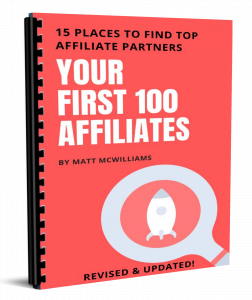 |
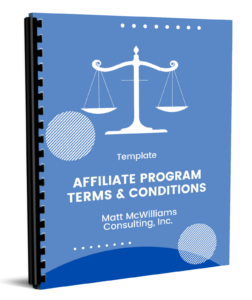 |
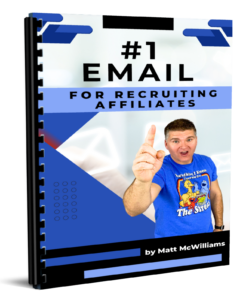 |
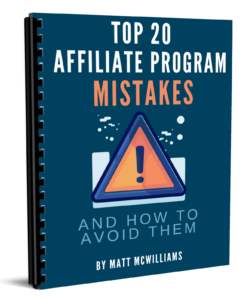 |
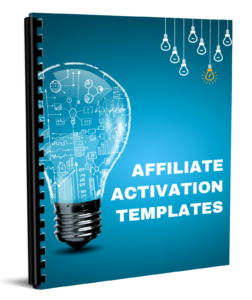 |
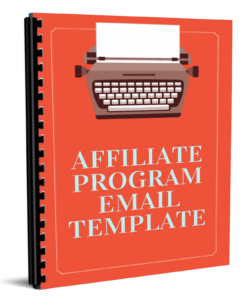 |
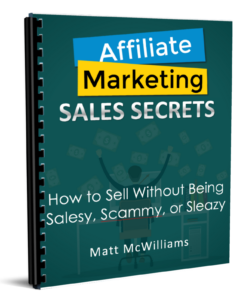 |
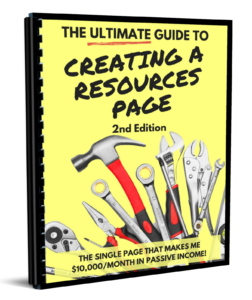 |
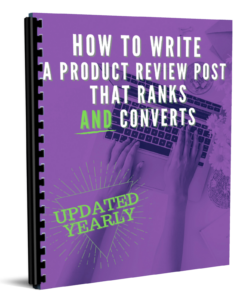 |

